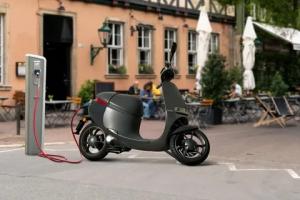Global and European Electric Motorcycles And Scooters Market Outlook 2025–2035
Electric Motorcycles and Scooters Market to Reach USD 62.9 Billion by 2035 as Urban Mobility Transforms Worldwide
NEWARK, DE, UNITED STATES, November 21, 2025 /EINPresswire.com/ -- The global electric motorcycles and scooters market is entering a new phase of expansion, supported by accelerating urban mobility transitions, government-led electrification programs, and rapid advancements in battery and charging technologies. According to the latest industry assessment, the market is set to grow from USD 38.6 billion in 2025 to USD 62.9 billion by 2035, representing a compound annual growth rate (CAGR) of 5.0% over the forecast period.
This decade-long upswing reflects the increasing shift toward low-emission, efficient, and cost-effective two-wheeled transport solutions across both developed and emerging markets. Electrification is becoming central to city-level transportation strategies, with fleet operators, delivery networks, and personal commuters driving adoption in unprecedented volumes.
Subscribe for Year-Round Insights → Stay ahead with quarterly and annual data updates
https://www.futuremarketinsights.com/reports/sample/rep-gb-22705
Scooters Lead Global Market Share With 58.7% Contribution in 2025
Scooters remain the dominant product segment, accounting for 58.7% of market revenue in 2025. Their compact form factor, practical design, and affordability make them ideal for congested urban environments. Cities across Southeast Asia, Western Europe, and Latin America are witnessing strong growth in scooter-sharing programs, further accelerating fleet demand.
Lightweight frames, improved durability, and integration of smart IoT-based mobility platforms have evolved the role of electric scooters from simple commuter vehicles to connected mobility assets. Stricter municipal emission standards continue to reinforce scooter-led adoption in major metropolitan areas.
Lithium-Ion Batteries Capture 69.2% Market Share in 2025
Lithium-ion (Li-ion) batteries are expected to account for 69.2% of the market in 2025, reaffirming their leadership as the preferred power source for modern two-wheeled EVs. Higher energy density, faster charging capability, lower long-term cost, and improved safety engineering remain the key advantages driving Li-ion adoption.
Falling prices of lithium, rapid commercialization of advanced battery chemistries, and maturing supply chains have expanded affordability across mass-market and premium segments. Battery management systems and modular battery packs are also enabling broader product diversification and compatibility with multiple vehicle platforms.
48V Voltage Systems to Hold 46.8% Market Share
The 48V system continues to dominate the voltage segmentation, contributing 46.8% of the market in 2025. Offering an optimal balance between torque, range, and cost, 48V architectures are widely deployed in mainstream scooter and motorcycle models. Their compatibility with existing charging ecosystems and ability to support responsive acceleration and improved hill-climbing performance make them an industry standard across global product lines.
Why Global Demand is Accelerating
The electric two-wheeler industry is benefiting from multiple structural and demand-side shifts, including:
• Urbanization and congestion: Dense cities increasingly prioritize compact, low-emission transport options.
• Incentives and regulations: Government subsidies, emission-free zones, and purchase rebates are lowering barriers to adoption.
• Cost efficiency: Electric scooters used in shared mobility networks report 24% lower maintenance costs and 18% higher uptime than internal combustion engine (ICE) models.
• Lifestyle-driven motorcycle demand: High-performance electric motorcycles witnessed a 35% surge in demand in 2025, particularly in Europe and North America, as consumers shift toward connected, premium two-wheelers.
• E-commerce and last-mile delivery: Rapid growth of urban logistics is raising demand for durable, low-cost, high-uptime electric scooters across Asia, India, Latin America, and select African markets.
Geographical Outlook: China and India Lead Global Growth
The market’s global expansion is underpinned by strong regional momentum:
• China – CAGR 6.8%: Backed by nationwide EV mandates, expansive charging infrastructure, advanced domestic OEM capabilities, and rising demand for connected and swappable battery scooters.
• India – CAGR 6.3%: Driven by rising fuel prices, FAME-II incentives, and rapid electrification within last-mile and shared mobility sectors. Battery leasing models and manufacturing expansion in key states reinforce growth.
• Germany – CAGR 5.8%: Benefiting from urban emission-reduction initiatives, premium e-motorcycle demand, and integration of connected fleet services.
• United Kingdom – CAGR 4.8%: Government-backed rebates, congestion zone exemptions, and increasing youth adoption support market penetration.
• United States – CAGR 4.3%: Growth centered in California, Texas, and New York with rising shared e-scooter deployments, high-performance EV motorcycle sales, and recreational electrification trends.
Personalize Your Experience: Ask for Customization to Meet Your Requirements
https://www.futuremarketinsights.com/customization-available/rep-gb-22705
Competitive Landscape: Innovation and Scale Shape Leadership
The market is moderately consolidated, led by major players including Yadea, AIMA, Niu Technologies, Hero Electric, Ampere Vehicles, Harley Davidson, Energica Motor Company, SUNRA, KTM, Tailing Electric Vehicle, Terra Motors, and Vmoto. Global players are pursuing scale efficiencies, modular vehicle platforms, and digital ecosystem integrations to cater to evolving mobility patterns.
Key strategic developments include:
• Hero MotoCorp’s launch of the Vida VX2 in June 2025, aimed at strengthening its mass-market electric scooter lineup in India.
• Expansion of swappable battery networks in China and Southeast Asia.
• European OEMs investing in over-the-air (OTA) software updates and telematics-enabled fleet solutions.
• Ride-sharing operators adopting battery-as-a-service (BaaS) to reduce downtime and upfront costs.
Market Outlook
With expanding infrastructure, declining battery costs, and rising environmental mandates, the electric motorcycles and scooters market is poised for continued growth over the next decade. The sector’s convergence with IoT, digital fleet management, battery innovation, and intelligent mobility platforms will further enhance performance, user experience, and lifecycle efficiency.
The full market report provides detailed insights across 40+ countries, covering product-level forecasts, battery technology adoption, competitive benchmarking, fleet monetization models, and sustainability-driven opportunities shaping the industry’s next phase.
Similar Industry Reports
Electric Aircraft Onboard Sensors Market
https://www.futuremarketinsights.com/reports/electric-aircraft-onboard-sensors-market
Electrical Label Market
https://www.futuremarketinsights.com/reports/electrical-labels-market
Electric Round Sprinklers Market
https://www.futuremarketinsights.com/reports/electric-round-sprinklers-market
Sudip Saha
Future Market Insights Inc.
+1 347-918-3531
email us here
Legal Disclaimer:
EIN Presswire provides this news content "as is" without warranty of any kind. We do not accept any responsibility or liability for the accuracy, content, images, videos, licenses, completeness, legality, or reliability of the information contained in this article. If you have any complaints or copyright issues related to this article, kindly contact the author above.

